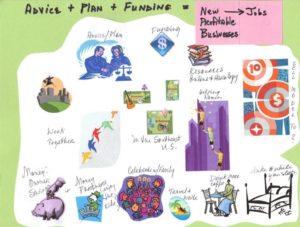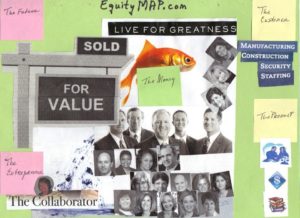I love posting things on the wall to organize my work day. What about you? What about birthday stickers and different emoji posts on Facebook and in texts? But when it comes to visualizing my dream business, what I want when I grow up, I can get stuck. All words and no pics – makes for “no fun” these days.
Back in the day, I decided to attend a class called “Operation Jumpstart”. The materials were provided by the Kauffman Foundation which is a well-respected resource for tons of research and business tips/materials. The course was offered by a local non-profit and the cost was nominal. The biggest commitment I had to make was the time to attend 36 hours of class time over a 12-week period and complete assigned homework. Yikes! Little did I know that I would feel like I was in grade school again. A story board (think emoji board, in today’s world)? Are you crazy? What is this going to do for me as a “seasoned” business strategist? I do not have time for this, nor did I ever like to draw.
After the initial rebellion, I proceeded to quickly put together the bare necessities to complete the board as assigned. When the next class was held, I was ready to turn mine in and be done. Over-achiever maybe? I was surprised to learn that no one else in the class had the understanding that this was homework, so the assignment was repeated and due date was extended to the following week. Oh, well, I am ahead of the game – but wait?
As I looked at what I had done, it became more obvious to me that I had not thought through many of the underlying components of the story board. If I was going to spend my time doing this, I needed to do it right – do you agree?
The five major sections on the story board were (1) the Entrepreneur (that’s me/you), (2) the Customer, (3) the Products/Services, (4) the Money, and (5) the Future. On the original board, I had pulled clip art to quickly fill in the “blanks”, so to speak, so that the story board would cover the five major sections e.g. homework would be completed with elements as required – and not much work on my part. The purpose of the story board was to tell the story of your business, the who, what, where, and how. Much to my surprise, I found the story board very helpful in forcing me to continue to clarify what I wanted to do, who my customers would be, where I would get the money to do what I wanted to do, and what the future might look like. More importantly, what exactly was I going to sell?
I know this is risky (maybe too transparent for some readers), but below is my original story board. Although roughly organized, this is where I started with my story – addressing the five important sections. Below is my storyboard. I am no artist and you can say or think whatever you wish…can you say “cheesy?”
For example, let’s start with the Entrepreneur – that’s me. See the lady in the black dress with a briefcase and flying over tall buildings like Wonder Woman? Well this is me! Don’t ask me why, but I just liked this image and thought it was appropriate. Sometimes I really do want to fly over tall buildings, but think better of it later. The rest of the images reflect the visualization of my dream at that time in my life.
The more I looked at the story board, the more work I saw that I needed to do. Too, too busy, and so many things I wanted to do. And the title – I put that up there last and then changed it a couple of times. You will see on the flip side of the story board, the title changed again. I guess this is part of the evolution of any plan – figuring things out, and not being afraid of changing if it is not the best fit at that time. The story board should evolve into a visual component of the business plan, like it or not!
On the flip side of the vision board (above), you can see the Future in the top left-hand corner with a “Sold – for Value” sign. This means that the vision was to grow the heck out of this business to create value thru revenue and earnings so that it could then be sold – maybe to a major banking system that needed fee income and more commercial loan customers. Sounds out there, to some of you, but I believed this could happen.
The Entrepreneur, that’s me, and my picture are on the bottom left of the story board with the phrase “The Collaborator”. This is the branding – collaborator – that is still important to me today.
The story board (today we might call it an Emoji Board or Info-gram?) made things more visible to me – several ideas were formed that previously I did not have. Even though I’m not an artist, I was glad that I took the time to complete the board – even if it was a not-so-favorite class assignment. Of course, when I look at it next month, there may be more work to do.
Oh, well, this is entrepreneurship…I love it.
For more information on Visualizing Your Dream and other business strategies, contact Nita Black at Info@NitaBlack.com or go to her website at www.NitaBlack.com. You can also find Nita on Facebook, LinkedIn, and Google+.
Plan for success!





